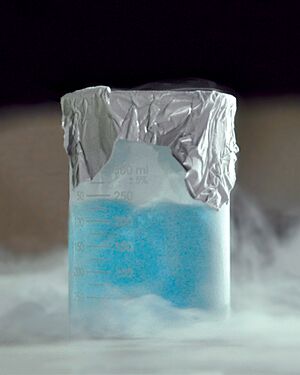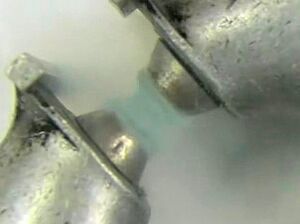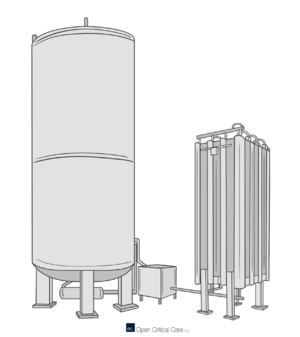Liquid oxygen facts for kids
Liquid oxygen, often called LOX, is a clear, light blue liquid. It is a special form of oxygen (O
2).
Oxygen is usually a gas, but when it gets super cold, it turns into a liquid. This amazing liquid was first used in 1926 by Robert H. Goddard in his first liquid-fueled rocket. Today, liquid oxygen is still very important for rockets and many other things.
Contents
What is Liquid Oxygen Like?
Liquid oxygen has a clear, light blue color. It is also very special because it is strongly paramagnetic. This means it can be held or even float between the poles of a strong magnet!
Liquid oxygen is a bit heavier than water. It is also extremely cold, which means it is a cryogenic liquid. It freezes at a super chilly temperature of -218.79 degrees Celsius (or 54.36 Kelvin). It boils and turns back into a gas at -182.95 degrees Celsius (or 90.19 Kelvin).
When liquid oxygen warms up, it expands a lot. One liter of liquid oxygen turns into 861 liters of oxygen gas! Because of this, it's used in some airplanes as a way to carry breathing oxygen.
Safety with Liquid Oxygen
Because liquid oxygen is so cold, it can make anything it touches very brittle. This means materials can become fragile and easily break.
Liquid oxygen is also a very powerful oxidizer. This means it helps things burn very quickly and strongly. If organic materials, like wood or cloth, get soaked in liquid oxygen, they can catch fire easily. They will burn very fast and with a lot of energy.
Some materials, like coal or asphalt, can even explode if they are soaked in liquid oxygen and then hit or sparked. This is why it's very important to be careful around liquid oxygen.
Liquid Oxygen and Liquid Nitrogen
Liquid nitrogen is another super cold liquid. It boils at an even lower temperature than liquid oxygen. Because of this, if you have liquid nitrogen in a container, it can actually pull oxygen out of the air. This oxygen then turns into liquid oxygen inside the container.
If most of the liquid nitrogen evaporates, you might be left with liquid oxygen. This can be dangerous if there are things that can burn nearby. It's like accidentally making a very strong fire starter!
How is Liquid Oxygen Used?

In business, liquid oxygen is known as an industrial gas. It is used for many different things in factories and hospitals.
Liquid oxygen is made from the air we breathe. Special factories called cryogenic air separation plants cool down air until it turns into a liquid. Then, they separate the oxygen from the other gases in the air.
Air forces around the world also use liquid oxygen. They use it to help rockets launch and to provide breathing oxygen for pilots flying at high altitudes. It's also used in hospitals to help people breathe.
Liquid Oxygen in Rockets

Liquid oxygen is one of the most common liquids used to help rockets launch into space. It's usually mixed with other fuels like liquid hydrogen, kerosene, or liquid methane. Liquid oxygen helps these fuels burn very powerfully, creating the thrust needed for rockets to fly.
Liquid oxygen was first used in the very first liquid-fueled rocket by Robert H. Goddard. It was also a key part of the famous World War II V-2 missile.
In the 1950s, during the Cold War, rockets like the American Redstone and Atlas, and the Soviet R-7 Semyorka all used liquid oxygen. Later, the powerful Apollo Saturn rockets that took astronauts to the Moon used liquid oxygen. The engines of the Space Shuttle main engines also relied on it.
Today, many rockets still use liquid oxygen. Here are some examples:
- Chinese space program
- CASC: Long March 5, Long March 6, Long March 7, Long March 8, Long March 12, Long March 9 (being developed), Long March 10 (being developed)
- LandSpace: Zhuque-2
- Space Pioneer: Tianlong-2
- European Space Agency: Ariane 6
- Indian Space Research Organisation: GSLV
- JAXA (Japan): H-IIA, H3
- Korea Aerospace Research Institute: Naro-1, Nuri
- Roscosmos (Russia): Soyuz-2, Angara
- United States
- Blue Origin: New Shepard, New Glenn (being developed)
- Firefly Aerospace: Firefly Alpha
- NASA: Space Launch System
- Rocket Lab: Electron, Neutron (being developed)
- SpaceX: Falcon 9, Falcon Heavy, Starship
- United Launch Alliance: Atlas V, Vulcan
History of Liquid Oxygen
- By 1845, a scientist named Michael Faraday had turned most known gases into liquids. But six gases, including oxygen, were very hard to liquefy. People called them "permanent gases."
- In 1877, two scientists, Louis Paul Cailletet in France and Raoul Pictet in Switzerland, were the first to make tiny drops of liquid air.
- Finally, in 1883, two Polish professors, Zygmunt Wróblewski and Karol Olszewski, made the first measurable amount of liquid oxygen. This was a big step in science!
See also
- Oxygen storage
- Industrial gas
- Cryogenics
- Liquid hydrogen
- Liquid helium
- Liquid nitrogen
- List of stoffs
- Natterer compressor
- Rocket fuel
- Solid oxygen
- Tetraoxygen




